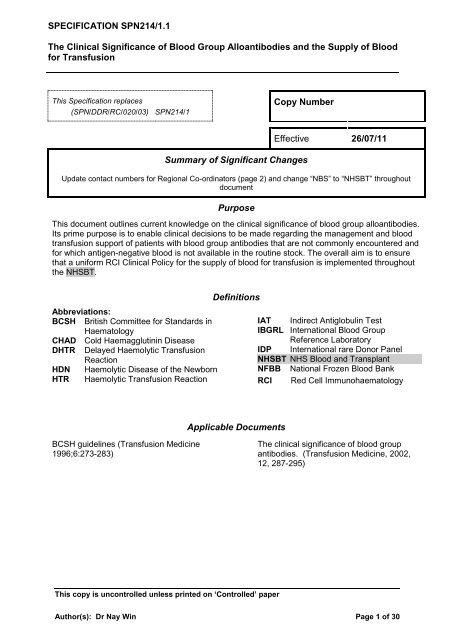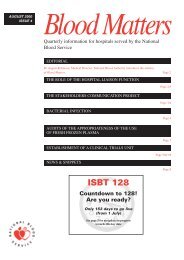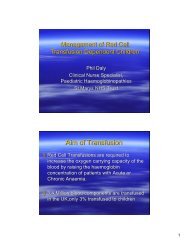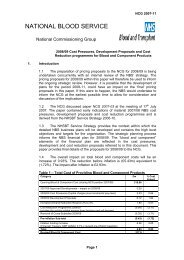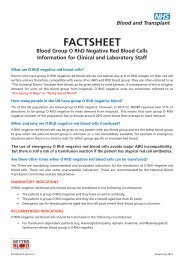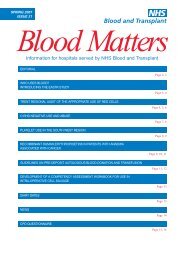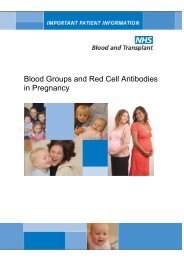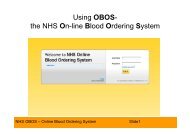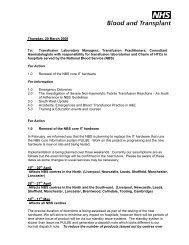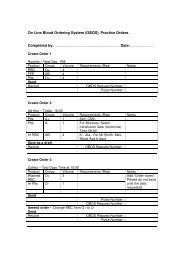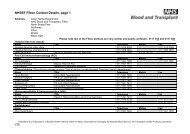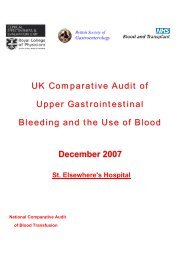Clinical Significance of Blood Group Alloantibodies and Supply of ...
Clinical Significance of Blood Group Alloantibodies and Supply of ...
Clinical Significance of Blood Group Alloantibodies and Supply of ...
You also want an ePaper? Increase the reach of your titles
YUMPU automatically turns print PDFs into web optimized ePapers that Google loves.
SPECIFICATION SPN214/1.1<br />
The <strong>Clinical</strong> <strong>Significance</strong> <strong>of</strong> <strong>Blood</strong> <strong>Group</strong> <strong>Alloantibodies</strong> <strong>and</strong> the <strong>Supply</strong> <strong>of</strong> <strong>Blood</strong><br />
for Transfusion<br />
This Specification replaces<br />
(SPN/DDR/RC/020/03) SPN214/1<br />
This copy is uncontrolled unless printed on ‘Controlled’ paper<br />
Copy Number<br />
Summary <strong>of</strong> Significant Changes<br />
Effective 26/07/11<br />
Update contact numbers for Regional Co-ordinators (page 2) <strong>and</strong> change “NBS” to “NHSBT” throughout<br />
document<br />
Purpose<br />
This document outlines current knowledge on the clinical significance <strong>of</strong> blood group alloantibodies.<br />
Its prime purpose is to enable clinical decisions to be made regarding the management <strong>and</strong> blood<br />
transfusion support <strong>of</strong> patients with blood group antibodies that are not commonly encountered <strong>and</strong><br />
for which antigen-negative blood is not available in the routine stock. The overall aim is to ensure<br />
that a uniform RCI <strong>Clinical</strong> Policy for the supply <strong>of</strong> blood for transfusion is implemented throughout<br />
the NHSBT.<br />
Abbreviations:<br />
BCSH British Committee for St<strong>and</strong>ards in<br />
Haematology<br />
CHAD Cold Haemagglutinin Disease<br />
DHTR Delayed Haemolytic Transfusion<br />
Reaction<br />
HDN Haemolytic Disease <strong>of</strong> the Newborn<br />
HTR Haemolytic Transfusion Reaction<br />
BCSH guidelines (Transfusion Medicine<br />
1996;6:273-283)<br />
Definitions<br />
Applicable Documents<br />
IAT Indirect Antiglobulin Test<br />
IBGRL International <strong>Blood</strong> <strong>Group</strong><br />
Reference Laboratory<br />
IDP International rare Donor Panel<br />
NHSBT NHS <strong>Blood</strong> <strong>and</strong> Transplant<br />
NFBB National Frozen <strong>Blood</strong> Bank<br />
RCI Red Cell Immunohaematology<br />
The clinical significance <strong>of</strong> blood group<br />
antibodies. (Transfusion Medicine, 2002,<br />
12, 287-295)<br />
Author(s): Dr Nay Win Page 1 <strong>of</strong> 30
SPECIFICATION SPN214/1.1<br />
The <strong>Clinical</strong> <strong>Significance</strong> <strong>of</strong> <strong>Blood</strong> <strong>Group</strong> <strong>Alloantibodies</strong> <strong>and</strong> the <strong>Supply</strong> <strong>of</strong> <strong>Blood</strong><br />
for Transfusion<br />
General Requirements<br />
Many <strong>of</strong> the antibodies described in this document are directed to high frequency antigens<br />
<strong>and</strong> may create difficulties in obtaining compatible blood. Red cells negative for high<br />
frequency antigens are not readily available <strong>and</strong> availability should be discussed with the<br />
National Frozen <strong>Blood</strong> Bank. Finding compatible blood should create no difficulty for<br />
patients with antibodies to antigens <strong>of</strong> lower frequency, but these antibodies may have to be<br />
considered when multiple specificities are present. Antibodies to lower frequency antigens<br />
may have the potential to cause haemolytic disease <strong>of</strong> the newborn (HDN). Therefore, the<br />
clinical significance <strong>of</strong> many <strong>of</strong> these antibodies is also described in this document.<br />
It is not possible to provide a strict policy on whether or not antigen-negative blood is<br />
required for transfusion, based purely on the specificity <strong>of</strong> the antibody. Other factors that<br />
need to be considered are:<br />
how urgently blood is required;<br />
the clinical diagnosis <strong>and</strong> the patient’s bone marrow function;<br />
whether the patient is immunologically compromised <strong>and</strong> unlikely to respond;<br />
strength <strong>and</strong> thermal amplitude <strong>of</strong> the antibody;<br />
class <strong>and</strong> subclass <strong>of</strong> the immunoglobulin;<br />
results <strong>of</strong> in vitro functional assays (e.g. a monocyte chemiluminescence assay, which<br />
may provide some indication <strong>of</strong> the potential clinical significance <strong>of</strong> the antibody);<br />
in vivo red cell survival. (Studies are difficult to correlate with clinical outcome as the<br />
behaviour <strong>of</strong> a small volume <strong>of</strong> labelled red cells may not accurately reflect the response<br />
to the transfusion <strong>of</strong> a large volume <strong>of</strong> red cells. Red cell survival studies are undertaken<br />
by very few service laboratories.)<br />
Where BCSH guidelines (Transfusion Medicine 1996;6:273-283) are provided for an<br />
antibody specificity these should be followed.<br />
When an antibody is identified <strong>and</strong> considered to be <strong>of</strong> no clinical significance,<br />
particular care must be taken to ensure that it is not masking the presence <strong>of</strong> another,<br />
clinically significant, antibody.<br />
Requests for rare units<br />
When rare units are required, all new cases should be authorised by the RCI/on-call<br />
consultant who should establish the clinical need, urgency <strong>and</strong> number <strong>of</strong> units required <strong>and</strong><br />
inform the centre RCI BMS. The RCI BMS should, in normal hours contact their Regional<br />
co-ordinator (out <strong>of</strong> hours approach the NFBB direct), to identify suitable units.<br />
The Regional Co-ordinator should search the NHSBT PULSE database to see if wet units<br />
are available before deciding to use frozen red cells. Where suitable units are not available<br />
in the NFBB, IBGRL should be contacted for advice regarding availability <strong>of</strong> donors on the<br />
International Panel.<br />
The Regional Co-ordinators: M&SW (Sue Search) - (2)7576<br />
SE (Martin Redman) - (6)2743<br />
North (Heather Webster) - (5)8703<br />
This copy is uncontrolled unless printed on ‘Controlled’ paper<br />
Author(s): Dr Nay Win Page 2 <strong>of</strong> 30
SPECIFICATION SPN214/1.1<br />
The <strong>Clinical</strong> <strong>Significance</strong> <strong>of</strong> <strong>Blood</strong> <strong>Group</strong> <strong>Alloantibodies</strong> <strong>and</strong> the <strong>Supply</strong> <strong>of</strong> <strong>Blood</strong><br />
for Transfusion<br />
National Frozen <strong>Blood</strong> Bank - (5) 7165<br />
[Out <strong>of</strong> hours – (5)7170]<br />
Joyce Poole, IBGRL - (2) 5787<br />
When compatible blood is not readily available<br />
The following strategies should be considered:<br />
1. Correction <strong>of</strong> anaemia wherever possible.<br />
2. Autologous pre-deposit (for surgery).<br />
3. Cell salvage (for surgery).<br />
4. Calling up donors <strong>of</strong> known phenotype.<br />
5. Consultation <strong>of</strong> the National <strong>and</strong> International Frozen <strong>Blood</strong> Banks.<br />
6. Mass screening <strong>of</strong> donations.<br />
7. Transfusing serologically incompatible (or ‘least incompatible’) blood, with or without<br />
immunosuppression.<br />
8. Testing members <strong>of</strong> the patient’s family, especially siblings.<br />
9. Consultation <strong>of</strong> the International Rare Donor Panel.<br />
When antigen-positive blood is to be transfused<br />
It is important to note that antibodies that show strong reactivity by IAT may be more active<br />
in vivo than if the same antibody showed weaker reactions. Where possible ‘serologically<br />
least incompatible’ units should be selected. Some <strong>of</strong> the antibodies listed are extremely<br />
rare <strong>and</strong> little or nothing is known about their clinical significance. Absence <strong>of</strong> evidence <strong>of</strong><br />
clinical significance does not mean that a transfusion <strong>of</strong> ‘incompatible’ blood will be<br />
uneventful. In these cases ABO compatible blood should be transfused with extra caution.<br />
Where appropriate, strategies for ameliorating the immunological response, such as the use<br />
<strong>of</strong> intravenous immunoglobulin <strong>and</strong> high dose steroids, should be considered. Advice on this<br />
may only be given to hospitals by an NHSBT consultant, who should discuss the case with<br />
an RCI consultant whenever time permits. Based on the few reported cases <strong>and</strong> anecdotal<br />
communications from NHSBT RCI consultants, the recommendation is that 0.4g/kg<br />
intravenous immunoglobulin (IVIG) together with 100 mg hydrocortisone IV are infused 6–8<br />
hours prior to a planned 'incompatible' transfusion <strong>and</strong> repeated once more 24 hours later.<br />
In emergencies the pre-transfusion dose should, ideally, be given as soon as possible before<br />
the transfusion. The transfusion should be given at the slowest rate consistent with the<br />
clinical condition <strong>and</strong> the patient observed closely throughout. (References: Kohan et al, Vox<br />
Sang 1994:67;195-198; Woodcock et al., Clin Lab Haemat 1993;15:59-61.)<br />
Occasionally, clinical urgency requires that blood must be transfused before the antibody<br />
has been identified or before a tentative identification has been confirmed. Under these<br />
circumstances, ABO compatible, serologically least incompatible blood should be transfused<br />
with extra caution. As discussed above, strategies for ameliorating the immunological<br />
response, such as the use <strong>of</strong> intravenous immunoglobulin <strong>and</strong> high dose steroids, should be<br />
considered.<br />
For some antibody specificities the recommendation is that serologically least incompatible<br />
red cells may be given, but that antigen-negative red cells should be provided for strong<br />
examples <strong>of</strong> the antibody (Table 1). Generally, a strong example <strong>of</strong> the antibody would be<br />
one giving a reaction strength grade 3 or greater (on a scale <strong>of</strong> 0-5) by IAT.<br />
This copy is uncontrolled unless printed on ‘Controlled’ paper<br />
Author(s): Dr Nay Win Page 3 <strong>of</strong> 30
SPECIFICATION SPN214/1.1<br />
The <strong>Clinical</strong> <strong>Significance</strong> <strong>of</strong> <strong>Blood</strong> <strong>Group</strong> <strong>Alloantibodies</strong> <strong>and</strong> the <strong>Supply</strong> <strong>of</strong> <strong>Blood</strong><br />
for Transfusion<br />
Antibodies to low frequency antigens<br />
Either blood negative for the corresponding antigen or blood compatible by IAT at 37 o C, as<br />
appropriate, may be supplied.<br />
HDN<br />
Virtually all antibodies reactive by IAT have been implicated in HDN (see BCSH Guidelines<br />
for testing protocols, Transfusion Medicine 1996;6:273-283). Whenever an IAT-reactive<br />
antibody is detected during pregnancy, a cord sample should be tested by a DAT <strong>and</strong>, if<br />
positive, the haemoglobin <strong>and</strong> bilirubin levels monitored to diagnose HDN. Haemolysis<br />
caused by antibodies to red cell antigens <strong>of</strong> lower frequency is generally not sufficiently<br />
severe to require intra-uterine transfusion (IUT), but blood may be required for neonatal<br />
transfusion. It should be noted that frozen <strong>and</strong> thawed red cells are both safe <strong>and</strong> effective<br />
for intrauterine <strong>and</strong> exchange transfusions (coagulation tests should be undertaken during<br />
<strong>and</strong> after neonatal exchange transfusions; in rare cases where there is a risk <strong>of</strong> bleeding,<br />
fresh frozen plasma (FFP) transfusions may be required).<br />
This copy is uncontrolled unless printed on ‘Controlled’ paper<br />
Author(s): Dr Nay Win Page 4 <strong>of</strong> 30
SPECIFICATION SPN214/1.1<br />
The <strong>Clinical</strong> <strong>Significance</strong> <strong>of</strong> <strong>Blood</strong> <strong>Group</strong> <strong>Alloantibodies</strong> <strong>and</strong> the <strong>Supply</strong> <strong>of</strong> <strong>Blood</strong><br />
for Transfusion<br />
Table 1a. Recommendations for red cells to be selected for transfusion<br />
Antibody Recommendation<br />
ABO<br />
Anti-A, -B, -A,B Antigen-negative red cells<br />
Anti-A1<br />
MNS<br />
Anti-M (active at 37 o C), -S, -s,<br />
-U<br />
Anti-N (active at 37 o C), -En a ,<br />
antibodies to low frequency<br />
MNS antigens (anti-‘Mi a ’)<br />
P<br />
Red cells compatible by IAT at 37 o C<br />
Antigen-negative red cells<br />
Red cells compatible by IAT at 37 o C<br />
Anti-P1 (active at 37 o C) Red cells compatible by IAT at 37 o C<br />
Rh<br />
All Rh antibodies (except anti-<br />
C w )<br />
Antigen-negative red cells<br />
Anti-C w Red cells compatible by IAT at 37 o C<br />
Lutheran<br />
Anti-Lu a Red cells compatible by IAT at 37 o C<br />
Anti-Lu b , -Lu3 Antigen-negative red cells<br />
Antibodies to other high<br />
frequency Lutheran antigens<br />
Kell<br />
All Kell antibodies (except anti-<br />
Kp a , -Ul a <strong>and</strong> -K17)<br />
Serologically least incompatible red cells, but antigen-negative red<br />
cells for strong examples <strong>of</strong> the antibody<br />
Antigen-negative red cells<br />
Anti-Kp a , Ul a , -K17 Red cells compatible by IAT at 37 o C<br />
Lewis<br />
Anti-Le a , -Le b , -Le a+b Red cells compatible by IAT at 37 o C<br />
Duffy<br />
All Duffy antibodies Antigen-negative red cells<br />
Kidd<br />
All Kidd antibodies Antigen-negative red cells<br />
Diego<br />
Anti-Di b , -Wr b Antigen-negative red cells<br />
Anti-Di a Red cells compatible by IAT at 37C<br />
This copy is uncontrolled unless printed on ‘Controlled’ paper<br />
Author(s): Dr Nay Win Page 5 <strong>of</strong> 30
SPECIFICATION SPN214/1.1<br />
The <strong>Clinical</strong> <strong>Significance</strong> <strong>of</strong> <strong>Blood</strong> <strong>Group</strong> <strong>Alloantibodies</strong> <strong>and</strong> the <strong>Supply</strong> <strong>of</strong> <strong>Blood</strong><br />
for Transfusion<br />
Anti-Wr a Red cells compatible by IAT at 37 o C<br />
Yt<br />
Anti-Yt a Serologically least incompatible red cells, but antigen-negative red<br />
cells for strong examples <strong>of</strong> the antibody<br />
Anti-Yt b Red cells compatible by IAT at 37 o C<br />
Xg<br />
Anti-Xg a Red cells compatible by IAT at 37 o C<br />
Scianna<br />
Anti-Sc1 Antigen-negative red cells<br />
Anti-Sc2 Red cells compatible by IAT at 37 o C<br />
Anti-Sc3 Ideally antigen-negative red cells, but, due to their extreme rarity,<br />
serologically least incompatible red cells should be used with extra<br />
caution<br />
Dombrock<br />
Anti-Do a , -Do b Red cells compatible by IAT at 37 o C<br />
Anti-Gy a , -Hy, -Jo a Serologically least incompatible red cells, but antigen-negative red<br />
cells for strong examples <strong>of</strong> the antibody<br />
Colton<br />
Anti-Co a Antigen-negative red cells<br />
Anti-Co b Red cells compatible by IAT at 37 o C<br />
Anti-Co3 Ideally antigen-negative red cells, but, due to their extreme rarity,<br />
serologically least incompatible red cells should be used with extra<br />
caution<br />
L<strong>and</strong>steiner-Wiener<br />
Anti-LW a , -LW ab Serologically least incompatible D– red cells<br />
Anti-LW b Red cells compatible by IAT at 37 o C<br />
Chido/Rodgers<br />
Chido/Rodgers antibodies Serologically least incompatible red cells<br />
H<br />
Anti-H (in Oh individuals) Antigen-negative red cells<br />
Anti-H/HI (in para-Bombay<br />
secretors)<br />
Anti-HI (in patients with<br />
common ABO phenotypes)<br />
Kx<br />
Red cells compatible by IAT at 37 o C (use ABO-identical)<br />
Red cells compatible by IAT at 37 o C<br />
Anti-Kx Antigen-negative red cells<br />
This copy is uncontrolled unless printed on ‘Controlled’ paper<br />
Author(s): Dr Nay Win Page 6 <strong>of</strong> 30
SPECIFICATION SPN214/1.1<br />
The <strong>Clinical</strong> <strong>Significance</strong> <strong>of</strong> <strong>Blood</strong> <strong>Group</strong> <strong>Alloantibodies</strong> <strong>and</strong> the <strong>Supply</strong> <strong>of</strong> <strong>Blood</strong><br />
for Transfusion<br />
Gerbich<br />
Gerbich antibodies Serologically least incompatible red cells<br />
Cromer<br />
Cromer antibodies Serologically least incompatible red cells, but antigen-negative red<br />
cells for strong examples <strong>of</strong> the antibody<br />
Knops<br />
Knops antibodies Serologically least incompatible red cells<br />
Indian<br />
Anti-In a Red cells compatible by IAT at 37 o C<br />
Anti-In b Serologically least incompatible red cells, but antigen-negative red<br />
cells for strong examples <strong>of</strong> the antibody<br />
Ok<br />
Anti-Ok a Ideally antigen-negative red cells, but, due to their extreme rarity,<br />
serologically least incompatible red cells should be used with extra<br />
caution<br />
John Milton Hagen<br />
Anti-JMH Serologically least incompatible red cells<br />
Ii<br />
Alloanti-I (active at 37 o C) Antigen-negative red cells<br />
Autoanti-I Red cells compatible by IAT at 37 o C<br />
Er<br />
Anti-Er a Serologically least incompatible red cells<br />
Globo<br />
Anti-P, -PP1P k Antigen-negative red cells<br />
Anti-LKE Serologically least incompatible red cells<br />
High frequency (901)<br />
Anti-Vel, -AnWj Antigen-negative red cells<br />
Anti-Lan, -At a , -Jr a Serologically least incompatible red cells, but antigen-negative red<br />
cells for strong examples <strong>of</strong> the antibody<br />
Anti-Emm, -PEL, -ABTI Serologically least incompatible red cells<br />
Anti-MAM Ideally antigen-negative red cells, but, due to their extreme rarity,<br />
serologically least incompatible red cells should be used with extra<br />
caution<br />
Anti-Sd a Serologically least incompatible red cells (avoid Sd(a+++) donors)<br />
This copy is uncontrolled unless printed on ‘Controlled’ paper<br />
Author(s): Dr Nay Win Page 7 <strong>of</strong> 30
SPECIFICATION SPN214/1.1<br />
The <strong>Clinical</strong> <strong>Significance</strong> <strong>of</strong> <strong>Blood</strong> <strong>Group</strong> <strong>Alloantibodies</strong> <strong>and</strong> the <strong>Supply</strong> <strong>of</strong> <strong>Blood</strong><br />
for Transfusion<br />
Table 1b. Recommendations for red cells to be selected for transfusion<br />
Give antigen-negative red cells<br />
Anti-A, -B, -A,B<br />
Anti-M (active at 37 o C), -S, -s, -U<br />
All Rh antibodies (except anti-C w )<br />
Anti-Lu b , -Lu3<br />
Kell antibodies (including anti-K, -k, -Kp b , -Js a , -Js b , -Ku) but not anti-Kp a , -Ul a <strong>and</strong> -K17)<br />
All Duffy antibodies (anti-Fy a , -Fy b , -Fy3, -Fy5)<br />
All Kidd antibodies (anti-Jk a , -Jk b , -Jk3)<br />
Anti-Di b , -Wr b<br />
Anti-Sc1<br />
Anti-Co a<br />
Anti-H (in Oh individuals)<br />
Anti-Kx<br />
Alloanti-I (active at 37 o C)<br />
Anti-P, -PP1P k<br />
Anti-Vel, -AnWj<br />
Give red cells compatible by IAT at 37 o C<br />
Anti-A1<br />
Anti-N (active at 37 o C), -En a , antibodies to low frequency MNS antigens (anti-‘Mi a ’)<br />
Anti-P1 (active at 37 o C)<br />
Anti-Lu a<br />
Anti-C w<br />
Anti-Le a , -Le b , -Le a+b<br />
Anti-Kp a , Ul a , -K17<br />
Anti-Wr a<br />
Anti-Yt b<br />
Anti-Xg a<br />
Anti-Do a , -Do b<br />
Anti-Di a<br />
Anti-Co b<br />
Anti-H/HI in para-Bombay, use ABO identical<br />
Anti-HI (in patients with common ABO phenotypes)<br />
Anti-In a<br />
Autoanti-I<br />
This copy is uncontrolled unless printed on ‘Controlled’ paper<br />
Author(s): Dr Nay Win Page 8 <strong>of</strong> 30
SPECIFICATION SPN214/1.1<br />
The <strong>Clinical</strong> <strong>Significance</strong> <strong>of</strong> <strong>Blood</strong> <strong>Group</strong> <strong>Alloantibodies</strong> <strong>and</strong> the <strong>Supply</strong> <strong>of</strong> <strong>Blood</strong><br />
for Transfusion<br />
Give serologically least incompatible red cells, but antigen-negative red cells for strong<br />
examples <strong>of</strong> the antibody<br />
Antibodies to other (not anti-Lu b or -Lu3) high frequency Lutheran antigens<br />
Anti-Yt a<br />
Anti-Gy a , -Hy, -Jo a<br />
Cromer antibodies<br />
Anti-In b<br />
Anti-Lan, -At a , -Jr a<br />
Give ABO/D compatible, least incompatible red cells<br />
Anti-LW a , -LW ab (use D–)<br />
Chido/Rodgers antibodies<br />
Gerbich antibodies<br />
Knops antibodies<br />
Anti-JMH<br />
Anti-Er a<br />
Anti-LKE<br />
Anti-Emm, -PEL, -ABTI<br />
Anti-Sd a (avoid Sd(a+++) donors)<br />
Ideally antigen-negative red cells should be given, but, due to their extreme rarity, ABO/D<br />
compatible, least incompatible red cells should be used with extra caution<br />
Anti-Sc3<br />
Anti-Co3<br />
Anti-Ok a<br />
Anti-MAM<br />
This copy is uncontrolled unless printed on ‘Controlled’ paper<br />
Author(s): Dr Nay Win Page 9 <strong>of</strong> 30
SPECIFICATION SPN214/1.1<br />
The <strong>Clinical</strong> <strong>Significance</strong> <strong>of</strong> <strong>Blood</strong> <strong>Group</strong> <strong>Alloantibodies</strong> <strong>and</strong> the <strong>Supply</strong> <strong>of</strong> <strong>Blood</strong><br />
for Transfusion<br />
<strong>Blood</strong> group antibodies<br />
Antibodies are presented below in the order <strong>of</strong> the ISBT blood group classification. A table<br />
summarising the recommendations for selection <strong>of</strong> suitable blood is provided above. An<br />
alphabetical index is provided at the end <strong>of</strong> the document.<br />
ABO system<br />
Anti-A, -B, <strong>and</strong> –A,B cause severe intravascular haemolytic transfusion reactions. Antigennegative<br />
blood must be selected for transfusion.<br />
Anti-A1 is rarely active at 37 o C <strong>and</strong> not considered clinically significant. IAT-compatible<br />
blood should be selected (BCSH guidelines).<br />
Plasma products with high titre ABO antibodies should only be given to group O recipients.<br />
MNS system<br />
Anti-M <strong>and</strong> -N can usually be ignored <strong>and</strong> are not detected by IAT at 37 o C. Rarely anti-M or<br />
-N are active at 37 o C <strong>and</strong> then are capable <strong>of</strong> causing transfusion reactions.<br />
If anti-M is active by IAT at 37 o C, M– blood must be selected (BCSH guidelines).<br />
If anti-N is active by IAT at 37 o C, IAT-compatible blood unselected for N may be used.<br />
About 22% <strong>of</strong> donors are M–<br />
About 28% <strong>of</strong> donors are N–<br />
Rarely, anti-M may cause HDN.<br />
Anti-S <strong>and</strong> -s can cause HTRs. Antigen-negative blood must be selected (BCSH<br />
guidelines).<br />
About 45% <strong>of</strong> donors are S–<br />
About 11% <strong>of</strong> donors are s–<br />
Anti-S <strong>and</strong> -s may cause HDN.<br />
Anti-U detects a high frequency antigen <strong>and</strong> has caused immediate <strong>and</strong> delayed HTRs. U–<br />
blood, which is also S– s–, must be selected.<br />
Occasionally anti-N present in a U– patient reacts, by IAT at 37 o C, with all red cells except<br />
those <strong>of</strong> the N– U– phenotype. When this occurs, N– U– blood should be selected.<br />
U– blood is usually only found in people <strong>of</strong> African origin. Contact NFBB for information<br />
regarding availability <strong>of</strong> ‘wet’ <strong>and</strong> frozen U– units.<br />
Anti-U may cause HDN.<br />
This copy is uncontrolled unless printed on ‘Controlled’ paper<br />
Author(s): Dr Nay Win Page 10 <strong>of</strong> 30
SPECIFICATION SPN214/1.1<br />
The <strong>Clinical</strong> <strong>Significance</strong> <strong>of</strong> <strong>Blood</strong> <strong>Group</strong> <strong>Alloantibodies</strong> <strong>and</strong> the <strong>Supply</strong> <strong>of</strong> <strong>Blood</strong><br />
for Transfusion<br />
Other antibodies to high frequency MNS antigens. These are the En a family <strong>of</strong> antibodies<br />
<strong>and</strong> are exceedingly rare. There are single reports <strong>of</strong> anti-En a causing a severe HTR <strong>and</strong><br />
severe HDN. If possible IAT-compatible blood should be selected. Consult IBGRL for<br />
availability <strong>of</strong> En(a-) donors on the IDP.<br />
Antibodies to low frequency MNS antigens. Antibodies generally referred to as anti-Mi a<br />
(including anti-Mur <strong>and</strong> -Vw) <strong>and</strong> the antigens they define are rare in Engl<strong>and</strong> but relatively<br />
common in Oriental people. They can cause immediate <strong>and</strong> delayed HTRs <strong>and</strong> severe<br />
HDN. IAT-compatible blood (most donors) must be selected.<br />
P1 system<br />
Anti-P1 are not usually reactive above 25 o C <strong>and</strong> these antibodies do not cause HTRs. Very<br />
rare examples <strong>of</strong> anti-P1 are reactive at 37 o C <strong>and</strong> can cause severe immediate or delayed<br />
HTRs. Units unselected for P1, compatible by IAT, should be used for transfusion<br />
when anti-P1 active at 37 o C is present (BCSH guidelines).<br />
About 20% <strong>of</strong> donors are P1– (P2).<br />
Anti-P1 has not been implicated in HDN.<br />
Rh system<br />
All Rh antibodies should be considered to be potentially clinically significant, capable <strong>of</strong><br />
causing both HTRs <strong>and</strong> HDN. BCSH guidelines recommend that when an Rh antibody<br />
reactive in IAT (the majority <strong>of</strong> Rh antibodies) is present, antigen-negative blood must<br />
be selected. However, as anti-C w has never been reported to have caused an HTR,<br />
IAT-compatible blood may be used when anti-C w is detected.<br />
All Rh antibodies have the potential to cause HDN.<br />
Antibodies to high frequency Rh antigens are rare. They include anti-Rh29, the antibody<br />
characteristically made by immunised Rhnull individuals, <strong>and</strong> anti-Hro (-Rh17) <strong>and</strong> related<br />
antibodies that detect epitopes on the RhCcEe protein.<br />
Anti-Rh29 Only Rhnull blood, which is extremely rare, is suitable.<br />
Anti-Hr0 (-Rh17). Only Rhnull or D-- (or related phenotype) blood is suitable.<br />
Other antibodies to high frequency antigens. These include antibodies such as anti-Hr,<br />
-Hr B , -Rh46, <strong>and</strong> -MAR. Rhnull or D-- blood would be suitable, but it might be easier to obtain<br />
blood lacking the specific antigen. .<br />
e-like antibodies. Anti-hr S <strong>and</strong> -hr B resemble anti-e <strong>and</strong> may be found in patients <strong>of</strong> African<br />
origin. They have not been reported to be clinically significant, but a particularly potent<br />
example might cause problems. R2R2 cells should be compatible, but the patient may then<br />
be stimulated to produce an antibody to a high frequency antigen (anti-Hr or -Hr B ) or anti-E.<br />
Consult NFBB for availability <strong>of</strong> hr S - <strong>and</strong> hr B -negative donors.<br />
This copy is uncontrolled unless printed on ‘Controlled’ paper<br />
Author(s): Dr Nay Win Page 11 <strong>of</strong> 30
SPECIFICATION SPN214/1.1<br />
The <strong>Clinical</strong> <strong>Significance</strong> <strong>of</strong> <strong>Blood</strong> <strong>Group</strong> <strong>Alloantibodies</strong> <strong>and</strong> the <strong>Supply</strong> <strong>of</strong> <strong>Blood</strong><br />
for Transfusion<br />
Anti-C w is a relatively common antibody. There is no report <strong>of</strong> anti-C w causing a transfusion<br />
reaction <strong>and</strong> IAT-compatible blood may be selected. Anti-C w has been implicated in HDN:<br />
one case <strong>of</strong> hydrops fetalis, attributed to anti-C w , has been reported. 1<br />
About 97% <strong>of</strong> donors are C w –.<br />
Antibodies to low frequency antigens. The Rh system contains many low frequency<br />
antigens. Antibodies to these antigens should all be considered to have the potential to<br />
cause HDN. Anti-E w , -Go a , -Be a , -Evans, <strong>and</strong> -Tar have all been implicated in HDN.<br />
Lutheran system<br />
Anti-Lu a has caused mild DHTRs. IAT-compatible blood should be selected.<br />
About 92% <strong>of</strong> donors are Lu(a–).<br />
Anti-Lu b has caused mild DHTRs. Antigen-negative blood should be selected.<br />
Anti-Lu3 is a very rare antibody produced by immunised individuals with the recessive type<br />
<strong>of</strong> Lunull [Lu(a–b–)]. Lunull blood should be selected. The dominant, In(Lu) type <strong>of</strong> Lunull is<br />
most readily available.<br />
Other antibodies to Lutheran system high frequency antigens have not been proven to<br />
be clinically significant. However, as a precaution Lunull blood should be selected for<br />
patients with strong examples <strong>of</strong> the antibody.<br />
Lutheran antibodies have not been implicated in severe HDN.<br />
Lewis system<br />
Lewis antibodies are not clinically significant, <strong>and</strong> can be ignored when selecting blood for<br />
transfusion.<br />
For anti-Le a , -Le b , <strong>and</strong> -Le a+b , blood compatible by IAT at 37 o C should be selected<br />
(BCSH guidelines).<br />
Most anti-Le b have Le bH specificity <strong>and</strong> might react strongly with group O red cells, but be<br />
non-reactive with group A1 or B cells.<br />
About 80% <strong>of</strong> donors are Le(a–).<br />
About 30% <strong>of</strong> donors are Le(b–).<br />
Lewis antibodies have not been implicated in severe HDN.<br />
Kell system<br />
Most Kell system antibodies are clinically significant <strong>and</strong> antigen-negative blood must be<br />
selected, except in the case <strong>of</strong> anti-Kp a .which has not been reported to cause haemolytic<br />
transfusion reactions.<br />
This copy is uncontrolled unless printed on ‘Controlled’ paper<br />
Author(s): Dr Nay Win Page 12 <strong>of</strong> 30
SPECIFICATION SPN214/1.1<br />
The <strong>Clinical</strong> <strong>Significance</strong> <strong>of</strong> <strong>Blood</strong> <strong>Group</strong> <strong>Alloantibodies</strong> <strong>and</strong> the <strong>Supply</strong> <strong>of</strong> <strong>Blood</strong><br />
for Transfusion<br />
Kell antibodies have the potential to cause HDN.<br />
Anti-k has caused severe immediate HTRs. k– blood must be selected. K+k– blood has a<br />
frequency <strong>of</strong> about 0.2%. If blood is not available locally, contact NFBB.<br />
Anti-Kp b has caused delayed HTRs. Kp(b–) blood must be selected. Kp(a+b–) blood has<br />
a frequency <strong>of</strong> about 0.01%<br />
Anti-Js b has caused delayed HTRs. Js(b–) blood must be selected. Js(a+b–) blood is<br />
very rare in a mainly white population.<br />
Anti-Ku, the antibody produced by immunised Ko individuals, can cause severe HTR. If<br />
possible, Ko blood (very rare) should be selected.<br />
Other antibodies to high frequency Kell antigens. These are very rare antibodies. None<br />
is reported to have caused an HTR, but antigen-negative blood is recommended if<br />
possible. In most cases, the only antigen-negative blood available will be Ko blood (see<br />
above).<br />
Antibodies to low frequency Kell antigens.<br />
Anti-Js a : antigen-negative blood (most donors) must be selected.<br />
Anti-Kp a , -Ul a , -K17: IAT-compatible blood is suitable.<br />
About 98% <strong>of</strong> donors are Kp(a–).<br />
About 99.7% <strong>of</strong> donors are K:–17.<br />
Duffy system<br />
Anti-Fy a <strong>and</strong> -Fy b have caused immediate <strong>and</strong> delayed HTRs<br />
The BCSH guidelines recommend that when Duffy antibodies are present, antigennegative<br />
blood must be selected.<br />
Both have the potential to cause HDN.<br />
About 32% <strong>of</strong> donors are Fy(a–).<br />
About 20% <strong>of</strong> donors are Fy(b–).<br />
Anti-Fy3 is a rare antibody detecting antigens on all red cells except those <strong>of</strong> the Fy(a–b–)<br />
phenotype. Anti-Fy3 has caused immediate <strong>and</strong> delayed HTRs. Fy(a–b–) blood must be<br />
selected.<br />
Anti-Fy5 is a rare antibody, similar to anti-Fy3, but it does not react with Fy(a–b–) or Rhnull<br />
cells. Anti-Fy5 has caused delayed HTRs; Fy(a–b–) blood must be selected.<br />
Fy(a–b–) phenotype is rare in Caucasians, but very common in people <strong>of</strong> African origin.<br />
Anti-Fy3 <strong>and</strong> -Fy5 have not been implicated in severe HDN.<br />
This copy is uncontrolled unless printed on ‘Controlled’ paper<br />
Author(s): Dr Nay Win Page 13 <strong>of</strong> 30
SPECIFICATION SPN214/1.1<br />
The <strong>Clinical</strong> <strong>Significance</strong> <strong>of</strong> <strong>Blood</strong> <strong>Group</strong> <strong>Alloantibodies</strong> <strong>and</strong> the <strong>Supply</strong> <strong>of</strong> <strong>Blood</strong><br />
for Transfusion<br />
Kidd system<br />
Anti-Jk a <strong>and</strong> -Jk b are dangerous antibodies as they are <strong>of</strong>ten difficult to detect, yet they are<br />
a common cause <strong>of</strong> delayed HTRs. Anti-Jk a have also caused immediate HTRs.<br />
The BCSH guidelines recommend that when Kidd antibodies are present, antigennegative<br />
blood must be selected.<br />
About 24% <strong>of</strong> donors are Jk(a–).<br />
About 27% <strong>of</strong> donors are Jk(b–).<br />
Kidd antibodies do not usually cause HDN, but there is one report <strong>of</strong> severe HDN due to<br />
anti-Jk a .<br />
Anti-Jk3 is a very rare antibody that reacts with all red cells except those <strong>of</strong> the Jk(a–b–)<br />
phenotype. It can cause immediate <strong>and</strong> delayed HTRs. Jk(a–b–) blood must be selected.<br />
Anti-Jk3 has not been implicated in HDN.<br />
Diego system<br />
Anti-Di a detects an antigen that is very rare in Caucasians, but polymorphic in people <strong>of</strong><br />
Eastern Asia <strong>and</strong> Native Americans. There is no firm evidence that anti-Di a has caused an<br />
HTR, but anti-Di a has haemolytic potential. IAT compatible blood (most donors) must be<br />
selected.<br />
Anti-Di a has been implicated in severe HDN.<br />
Anti-Di b is a rare antibody that detects an antigen <strong>of</strong> very high frequency. There is no clear<br />
evidence that anti-Di b has caused an HTR, but it has been implicated in HDN. Antigennegative<br />
blood should be selected.<br />
Anti-Wr a is a relatively common antibody to a very low frequency antigen. It has caused<br />
HTRs. If anti-Wr a is detected, IAT-compatible blood must be selected.<br />
Anti-Wr a has caused severe HDN<br />
Anti-Wr b is a rare alloantibody to a very high frequency antigen. There is no report <strong>of</strong> anti-<br />
Wr b causing an HTR or HDN. If possible, for strong antibodies, antigen-negative blood<br />
should selected. Wr(b–) blood is extremely rare.<br />
Other antibodies <strong>of</strong> the Diego system all detect antigens <strong>of</strong> very low frequency. None has<br />
caused an HTR, but anti-ELO (-DI8) <strong>and</strong> -BOW (-DI15) have caused severe HDN. IATcompatible<br />
blood (most donors) should be selected.<br />
Yt system<br />
Anti-Yt a detects an antigen with a frequency <strong>of</strong> about 99.7%. Anti-Yt a has rarely been<br />
responsible for a HTR. Yt(a–) blood is not usually required for transfusion, but is<br />
recommended for strong examples <strong>of</strong> the antibody.<br />
This copy is uncontrolled unless printed on ‘Controlled’ paper<br />
Author(s): Dr Nay Win Page 14 <strong>of</strong> 30
SPECIFICATION SPN214/1.1<br />
The <strong>Clinical</strong> <strong>Significance</strong> <strong>of</strong> <strong>Blood</strong> <strong>Group</strong> <strong>Alloantibodies</strong> <strong>and</strong> the <strong>Supply</strong> <strong>of</strong> <strong>Blood</strong><br />
for Transfusion<br />
There is no report <strong>of</strong> anti-Yt a causing HDN.<br />
Anti-Yt b detects an antigen with a frequency <strong>of</strong> about 8%. There is no report <strong>of</strong> anti-Yt b<br />
causing a HTR or HDN. IAT compatible blood should be selected.<br />
Xg system<br />
Anti-Xg a detects an antigen with a frequency <strong>of</strong> 66% in males <strong>and</strong> 89% in females. There is<br />
no report <strong>of</strong> a HTR due anti-Xg a . Xg a typed donor blood is not available, but IAT-compatible<br />
blood should be selected.<br />
Anti-Xg a has not been implicated in HDN.<br />
Scianna system<br />
Anti-Sc1 <strong>and</strong> -Sc3 detect antigens <strong>of</strong> very high frequency. There is no report <strong>of</strong> either<br />
antibody causing a HTR or HDN. The antibodies are IgG <strong>and</strong> usually potent, but evidence <strong>of</strong><br />
clinical significance is limited because <strong>of</strong> the rarity <strong>of</strong> the antibodies. Antigen-negative<br />
blood should be selected, if possible. Sc:–1, 2, 3 blood may be available, but is extremely<br />
rare. Sc:–1,–2,–3 donors are not available. When anti-Sc3 is present, serologically least<br />
incompatible blood may be given with extra caution.<br />
Anti-Sc2, which detects an antigen <strong>of</strong> low frequency, has not been reported to have caused<br />
a HTR or HDN. IAT-compatible blood (most donors) should be selected.<br />
Dombrock system<br />
Anti-Do a <strong>and</strong> -Do b are generally found in sera containing multiple red cell antibodies. They<br />
have caused immediate <strong>and</strong> delayed HTRs. Finding compatible blood may be complicated<br />
by the presence <strong>of</strong> the other antibodies. In most instances typed donors are not available.<br />
IAT-compatible blood should be selected.<br />
About 34% <strong>of</strong> donors are Do(a–).<br />
About 18% <strong>of</strong> donors are Do(b–).<br />
Anti-Gy a , -Hy, <strong>and</strong> -Jo a are rare antibodies that detect antigens <strong>of</strong> very high frequency.<br />
There is one report <strong>of</strong> anti-Hy causing an HTR, but, because <strong>of</strong> the rarity <strong>of</strong> the antibodies,<br />
evidence <strong>of</strong> clinical significance is limited. Antigen-negative blood is not usually required<br />
for transfusion, but is recommended for strong examples <strong>of</strong> the antibody.<br />
No Dombrock antibody has caused HDN.<br />
Colton system<br />
Anti-Co a detects an antigen <strong>of</strong> high frequency <strong>and</strong> has caused delayed HTRs <strong>and</strong> severe<br />
HDN. Co(a–) blood should be selected.<br />
About 0.2% <strong>of</strong> donors are Co(a–).<br />
This copy is uncontrolled unless printed on ‘Controlled’ paper<br />
Author(s): Dr Nay Win Page 15 <strong>of</strong> 30
SPECIFICATION SPN214/1.1<br />
The <strong>Clinical</strong> <strong>Significance</strong> <strong>of</strong> <strong>Blood</strong> <strong>Group</strong> <strong>Alloantibodies</strong> <strong>and</strong> the <strong>Supply</strong> <strong>of</strong> <strong>Blood</strong><br />
for Transfusion<br />
Anti-Co b is a rare antibody that detects an antigen with a frequency <strong>of</strong> about 8.5%. One<br />
case <strong>of</strong> a mild HTR due to anti-Co b is reported. IAT-compatible blood (90% <strong>of</strong> donors)<br />
should be selected.<br />
Anti-Co b has not been implicated in HDN.<br />
Anti-Co3 is a very rare antibody detecting an antigen <strong>of</strong> very high frequency. Anti-Co3 has<br />
caused a mild HTR <strong>and</strong> HDN. Ideally, Co(a–b–) blood should be selected for<br />
compatibility testing, but is extremely rare. Serologically least incompatible blood<br />
may be given with extra caution.<br />
LW system<br />
Anti-LW a <strong>and</strong> -LW ab detect antigens <strong>of</strong> very high frequency. There is no report <strong>of</strong> either<br />
antibody causing a HTR. Antigen-negative blood may not be required for transfusion,<br />
but D– blood should be selected (unless anti-c is present in an R1R1 LW(a–) patient).<br />
Anti-LW b , which detects an antigen <strong>of</strong> low frequency, has not been reported to have caused<br />
a HTR. IAT-compatible blood (most donors) should be selected.<br />
No LW antibody has been implicated in HDN.<br />
Chido/Rodgers system<br />
Chido/Rodgers antibodies detect C4 antigens that become attached to the red cell surface<br />
in vivo. No Chido/Rodgers antibody has caused an HTR <strong>and</strong> antigen-negative blood is<br />
not required for transfusion. (Use serum neutralised with AB serum for compatibility<br />
testing).<br />
H system<br />
Anti-H is always present in the serum <strong>of</strong> individuals with the Oh (Bombay) phenotype (red<br />
cell H-deficient, non-secretor). Like anti-A <strong>and</strong> -B, -H is likely to cause a severe immediate<br />
HTR. <strong>Blood</strong> <strong>of</strong> the Oh (Bombay) phenotype must be selected.<br />
Some non-secretors <strong>of</strong> A or B genotype have very low levels <strong>of</strong> red cell H <strong>and</strong> have the<br />
‘para-Bombay’ Ah or Bh phenotype. These individuals usually have anti-H in their serum,<br />
though this is rarely <strong>of</strong> high titre. Little information exists on the clinical significance <strong>of</strong> anti-H<br />
in Ah or Bh individuals. Ideally Oh (Bombay) phenotype should be selected, but if not<br />
available red cells <strong>of</strong> the appropriate ABO group (A for Ah, B for Bh) may be used.<br />
Anti-H may rarely cause severe HDN.<br />
Anti-HI is present in the serum <strong>of</strong> individuals with some para-Bombay phenotypes (red cell<br />
H-deficient, secretor). Anti-HI is unlikely to be active at 37 o C. ABO-identical blood,<br />
compatible at 37 o C, can be used for transfusion.<br />
This copy is uncontrolled unless printed on ‘Controlled’ paper<br />
Author(s): Dr Nay Win Page 16 <strong>of</strong> 30
SPECIFICATION SPN214/1.1<br />
The <strong>Clinical</strong> <strong>Significance</strong> <strong>of</strong> <strong>Blood</strong> <strong>Group</strong> <strong>Alloantibodies</strong> <strong>and</strong> the <strong>Supply</strong> <strong>of</strong> <strong>Blood</strong><br />
for Transfusion<br />
Anti-HI may be found in group A1, A1B, <strong>and</strong> B individuals <strong>and</strong> may be active at 37 o C. <strong>Blood</strong><br />
that is compatible at 37 o C can be used for transfusion. If the antibody is active at<br />
37 o C, blood <strong>of</strong> the ABO group <strong>of</strong> the patient should be used. <strong>Group</strong> O <strong>and</strong> A2 blood<br />
should not be used.<br />
Kx system<br />
Anti-Kx is a rare antibody found in the serum <strong>of</strong> immunised individuals with McLeod<br />
syndrome, usually together with anti-Km. Anti-Kx + -Km has caused severe HTRs. If<br />
possible, antigen-negative (McLeod phenotype) blood should be selected.<br />
Gerbich system<br />
Anti-Ge2, -Ge3, <strong>and</strong> -Ge4 detect antigens <strong>of</strong> very high frequency. There is no firm evidence<br />
that any <strong>of</strong> these antibodies has caused a HTR. Antigen-negative blood is not usually<br />
required for transfusion,<br />
Anti-Ge3 has caused severe HDN.<br />
Antibodies to low frequency antigens. None <strong>of</strong> these antibodies has caused an HTR.<br />
Cromer system<br />
Anti-Cr a , -Tc a , -Dr a , -Es a , -IFC, -WES b , -UMC. There is no firm evidence that any <strong>of</strong> these<br />
rare antibodies has caused a HTR <strong>and</strong> the evidence from functional cellular assays is<br />
equivocal. Antigen-negative blood is not usually required for transfusion, but should<br />
be considered for strong examples <strong>of</strong> the antibody. Typed donors are not available in<br />
the UK.<br />
Antibodies to low frequency antigens. None <strong>of</strong> these antibodies has caused an HTR.<br />
No Cromer antibody has been implicated in HDN.<br />
Knops system <strong>and</strong> the COST antibodies<br />
Anti-Kn a , -McC a , -Sl a , -Yk a , <strong>and</strong> -Cs a detect antigens <strong>of</strong> relatively high frequency.<br />
Anti-Kn b , -McC b , -Vil, <strong>and</strong> -Cs b detect antigens <strong>of</strong> relatively low frequency.<br />
All <strong>of</strong> these antibodies can be considered to be <strong>of</strong> no clinical significance <strong>and</strong> can be<br />
ignored when selecting blood for transfusion. Use <strong>of</strong> least-incompatible blood will<br />
reduce the hazard <strong>of</strong> masking other, clinically-significant, antibodies.<br />
No Knops antibody has caused HDN.<br />
This copy is uncontrolled unless printed on ‘Controlled’ paper<br />
Author(s): Dr Nay Win Page 17 <strong>of</strong> 30
SPECIFICATION SPN214/1.1<br />
The <strong>Clinical</strong> <strong>Significance</strong> <strong>of</strong> <strong>Blood</strong> <strong>Group</strong> <strong>Alloantibodies</strong> <strong>and</strong> the <strong>Supply</strong> <strong>of</strong> <strong>Blood</strong><br />
for Transfusion<br />
Indian (In) system<br />
Anti-In b is a rare antibody that recognises an antigen <strong>of</strong> very high frequency. There is one<br />
reported case <strong>of</strong> anti-In b causing a HTR. In(b–) blood is not usually required for<br />
transfusion, but should be considered for strong examples <strong>of</strong> the antibody.<br />
Anti-In a is a rare antibody that detects an antigen that is rare in populations <strong>of</strong> European<br />
origin, but with a frequency <strong>of</strong> about 3% in Indians <strong>and</strong> 10% in Arabs. Anti-In a is not reported<br />
to be clinically significant. IAT-compatible red cells should be selected for transfusion.<br />
Anti-In a <strong>and</strong> -In b have not been implicated in HDN.<br />
Ok system<br />
Anti-Ok a . Only two examples <strong>of</strong> anti-Ok a are known <strong>and</strong> both were in Japan <strong>and</strong> neither was<br />
transfused. In vivo survival tests <strong>and</strong> cellular functional assays suggest that anti-Ok a is<br />
clinically significant. Ok(a–) blood is extremely rare. When Ok(a–) blood is not available,<br />
serologically least incompatible blood may be given with extra caution.<br />
Anti-Ok a has not been implicated in HDN.<br />
JMH system<br />
Anti-JMH detects an antigen <strong>of</strong> high frequency <strong>and</strong> JMH– is usually an acquired phenotype.<br />
Anti-JMH is not considered clinically significant. Serologically least incompatible blood<br />
may be used for transfusion.<br />
Anti-JMH has not been implicated in HDN.<br />
I<br />
Anti-I is always present as an alloantibody in the serum <strong>of</strong> individuals with the rare<br />
phenotype adult I– i+, although it is more commonly found as an autoantibody in CHAD<br />
patients. I+ blood transfused to patients with allo anti-I– has caused increased destruction <strong>of</strong><br />
cells <strong>and</strong> therefore I– blood should be considered if the anti-I is active at 37 o C. I– blood<br />
is not required when auto anti-I is present.<br />
Anti-I has not been implicated in HDN.<br />
Er<br />
Anti-Er a <strong>and</strong> -Er b are rare antibodies detecting antigens <strong>of</strong> high <strong>and</strong> low frequency,<br />
respectively. There is no evidence that they are clinically significant, but the antibodies are<br />
extremely rare <strong>and</strong> little clinical data are available. Er(a–) blood is not available in the UK.<br />
Serologically least incompatible blood should be used with extra caution.<br />
Anti-Er a <strong>and</strong> -Er b have not been implicated in HDN.<br />
This copy is uncontrolled unless printed on ‘Controlled’ paper<br />
Author(s): Dr Nay Win Page 18 <strong>of</strong> 30
SPECIFICATION SPN214/1.1<br />
The <strong>Clinical</strong> <strong>Significance</strong> <strong>of</strong> <strong>Blood</strong> <strong>Group</strong> <strong>Alloantibodies</strong> <strong>and</strong> the <strong>Supply</strong> <strong>of</strong> <strong>Blood</strong><br />
for Transfusion<br />
P, ‘P,P1,P k ’, LKE<br />
Anti-P <strong>and</strong> anti-P,P1,P k are antibodies always present in individuals with the rare P k <strong>and</strong> p<br />
phenotypes, respectively. Both antibodies can react at 37 o C, be strongly haemolytic, <strong>and</strong><br />
can cause HTR. Antigen-negative red cells must be selected. Both antibodies are<br />
compatible with p cells, anti-P is also compatible with P k cells.<br />
Neither anti-P nor -P,P1,P k has been reported to cause HDN, but there is a high rate <strong>of</strong> early<br />
spontaneous abortion.<br />
Anti-LKE detect an antigen <strong>of</strong> high frequency absent from P k <strong>and</strong> p cells. These antibodies<br />
are generally only active at low temperature <strong>and</strong> there is no report <strong>of</strong> a HTR. Serologically<br />
least incompatible blood may be used.<br />
Antibodies to antigens <strong>of</strong> low frequency (700 series)<br />
Antibodies to low frequency antigens do not present a transfusion problem, as compatible<br />
blood is readily available.<br />
Some <strong>of</strong> the antibodies in this series have caused HDN. These are anti-JFV, -Kg, -JONES, -<br />
HJK, <strong>and</strong> -REIT.<br />
Antibodies to antigens <strong>of</strong> high frequency (901 series)<br />
All the antibodies in this section detect antigens <strong>of</strong> very high frequency.<br />
Anti-Vel are <strong>of</strong>ten complement-activating IgM antibodies that cause severe immediate<br />
HTRs. Vel– blood must be selected.<br />
There is no report <strong>of</strong> anti-Vel causing HDN.<br />
Anti-Lan. One example <strong>of</strong> anti-Lan is reported to have caused an immediate HTR. Lan–<br />
blood is not usually required for transfusion, but should be considered for strong<br />
examples <strong>of</strong> the antibody.<br />
There is no report <strong>of</strong> anti-Lan causing HDN.<br />
Anti-At a has been reported to have caused a transfusion reaction. At(a–) blood is not<br />
usually required for transfusion, but should be considered for strong examples <strong>of</strong> the<br />
antibody. At(a–) blood is not available in the UK.<br />
There is one report <strong>of</strong> anti-At a causing mild HDN.<br />
Anti-Jr a . There is little evidence that anti-Jr a has caused a HTR <strong>and</strong> there is no report <strong>of</strong><br />
HDN. Jr(a–) blood is not usually required for transfusion, but should be considered<br />
for strong examples <strong>of</strong> the antibody. Jr(a–) blood is not available in the UK.<br />
Anti-Emm. Only five examples <strong>of</strong> anti-Emm are known <strong>and</strong> there is no evidence <strong>of</strong> clinical<br />
significance. Serologically least incompatible blood can be used.<br />
This copy is uncontrolled unless printed on ‘Controlled’ paper<br />
Author(s): Dr Nay Win Page 19 <strong>of</strong> 30
SPECIFICATION SPN214/1.1<br />
The <strong>Clinical</strong> <strong>Significance</strong> <strong>of</strong> <strong>Blood</strong> <strong>Group</strong> <strong>Alloantibodies</strong> <strong>and</strong> the <strong>Supply</strong> <strong>of</strong> <strong>Blood</strong><br />
for Transfusion<br />
Anti-AnWj has caused severe HTRs. IAT-compatible blood must be selected. Red cells<br />
<strong>of</strong> the Lunull (dominant InLu type) phenotype have very low expression <strong>of</strong> AnWj <strong>and</strong> are<br />
suitable for transfusion.<br />
There is no report <strong>of</strong> anti-AnWj causing HDN.<br />
Anti-PEL. Only two examples <strong>of</strong> anti-PEL <strong>and</strong> two anti-PEL-like are known. In vivo survival<br />
studies suggest that anti-PEL would not cause a HTR. Serologically least incompatible<br />
blood should be used.<br />
Anti-ABTI. Only three examples <strong>of</strong> anti-ABTI are known <strong>and</strong> there is little information on<br />
their clinical significance. Typed donor blood is not available. Serologically least<br />
incompatible blood should be used.<br />
Anti-MAM is a very rare antibody. Only four examples <strong>of</strong> anti-MAM are known <strong>and</strong> are<br />
potent IgG antibodies. Anti-MAM has not caused a HTR, but it has caused severe HDN<br />
MAM– blood is not available <strong>and</strong> serologically least incompatible blood with<br />
immunosuppressive therapy may be necessary.<br />
Sd a<br />
Anti-Sd a detects an antigen with a frequency <strong>of</strong> about 91%. The strength <strong>of</strong> Sd a is very<br />
variable. Although anti-Sd a is not generally considered a transfusion hazard, <strong>and</strong> Sd(a–) red<br />
cells are not required for transfusion. Serologically least incompatible red cells should<br />
be selected (avoid Sd(a+++) cells).<br />
This copy is uncontrolled unless printed on ‘Controlled’ paper<br />
Author(s): Dr Nay Win Page 20 <strong>of</strong> 30
SPECIFICATION SPN214/1.1<br />
The <strong>Clinical</strong> <strong>Significance</strong> <strong>of</strong> <strong>Blood</strong> <strong>Group</strong> <strong>Alloantibodies</strong> <strong>and</strong> the <strong>Supply</strong> <strong>of</strong> <strong>Blood</strong><br />
for Transfusion<br />
Table 2 Antibodies to blood group antigens showing published clinical significance<br />
Ag freq = Frequency <strong>of</strong> antigen detected. H = high. L = low. P = polymorphic.<br />
HTR = haemolytic transfusion reaction. I = immediate. D = delayed.<br />
Anti- Ag freq HTR HDN<br />
ABO1 A P Yes. I Possibly mild<br />
ABO2 B P Yes. I Possibly mild<br />
ABO3 A,B P Yes. I Usually mild<br />
ABO4 A1 P Yes. I & D if active at 37 C No report<br />
MNS1 M P Yes. I & D if active at 37 C Severe<br />
MNS2 N P Yes. I & D if active at 37 C Possibly mild (1 case)<br />
MNS3 S P Yes Severe<br />
MNS4 s P Yes. D Severe<br />
MNS5 U P Yes. I & D Severe<br />
MNS6<br />
MNS7<br />
He<br />
Mi<br />
P No report No report<br />
a L Yes. I & D Severe<br />
MNS9 Vw L Possibly Severe<br />
MNS10<br />
MNS11<br />
Mur<br />
M<br />
P Yes. I & D Severe<br />
g L No report No report<br />
MNS12<br />
MNS13<br />
Vr<br />
M<br />
L No report No report<br />
e<br />
MNS14 Mt<br />
P No report No report<br />
a L No report Yes<br />
MNS15 St a<br />
L No report No report<br />
MNS16 Ri a<br />
L No report No report<br />
MNS17 Cl a L No report No report<br />
MNS18 Ny a L No report No report<br />
MNS19 Hut L No report No report<br />
MNS20 Hil L No report Yes (1 case)<br />
MNS21 M v L No report Yes<br />
MNS22 Far L Yes (1 case) Severe<br />
MNS23 s D<br />
L No report Yes<br />
MNS24 Mit L No report No report<br />
MNS25 Dantu L No report No report<br />
MNS26 Hop L No report No report<br />
MNS27 Nob L Minor symptoms (1 case) No report<br />
MNS28 En a H Severe (1 case) Severe (1 case)<br />
MNS29 ENKT H No report No report<br />
MNS31 Or L No report No report<br />
MNS32 DANE L No report No report<br />
MNS33 TSEN L No report No report<br />
MNS34 MINY L No report No report<br />
MNS35 MUT L No report No report<br />
MNS36 SAT L No report No report<br />
This copy is uncontrolled unless printed on ‘Controlled’ paper<br />
Author(s): Dr Nay Win Page 21 <strong>of</strong> 30
SPECIFICATION SPN214/1.1<br />
The <strong>Clinical</strong> <strong>Significance</strong> <strong>of</strong> <strong>Blood</strong> <strong>Group</strong> <strong>Alloantibodies</strong> <strong>and</strong> the <strong>Supply</strong> <strong>of</strong> <strong>Blood</strong><br />
for Transfusion<br />
Anti- Ag freq HTR HDN<br />
MNS37 ERIK L No report No report<br />
MNS38 Os a<br />
L No report No report<br />
MNS39 ENEP H No report No report<br />
MNS40 ENEH H No report No report<br />
MNS41 HAG L No report No report<br />
MNS42 ENAV H No report No report<br />
MNS43 MARS L No report No report<br />
P1 P1 P Yes. I & D if active at 37 C No report<br />
RH1 D P Severe Severe<br />
RH2 C P Yes. I & D Yes<br />
RH3 E P Yes. I & D Yes<br />
RH4 c P Severe Severe<br />
RH5 e P Yes. I & D Yes<br />
RH6 f P Yes. D Yes<br />
RH7 Ce P Yes Yes<br />
RH8 C w P No report Yes<br />
RH9 C x L No report Yes, mild<br />
RH10 V P No report No report<br />
RH11 E w L No report Yes<br />
RH12 G P Yes Yes<br />
RH17 Hro H No report Severe<br />
RH18 Hr H No report Yes<br />
RH19 hr S P No report No report<br />
RH20 VS P No report No report<br />
RH22 CE P No report No report<br />
RH23 D w L No report No report<br />
RH27 cE P No report No report<br />
RH29 total Rh H Yes Severe<br />
RH30 Go a L Yes, D Yes<br />
RH31 hr B P No report No report<br />
RH32 R N L No report Yes<br />
RH33 Har L No report No report<br />
RH34 Hr B H No report No report<br />
RH35 L No report No report<br />
RH36 Be a L No report Severe<br />
RH37 Evans L No report Yes<br />
RH40 Tar L No report Yes<br />
RH42 Cce s P No report Mild<br />
RH44 Nou H No report No report<br />
RH45 Riv L No report Mild<br />
RH46 Sec H No report Severe<br />
This copy is uncontrolled unless printed on ‘Controlled’ paper<br />
Author(s): Dr Nay Win Page 22 <strong>of</strong> 30
SPECIFICATION SPN214/1.1<br />
The <strong>Clinical</strong> <strong>Significance</strong> <strong>of</strong> <strong>Blood</strong> <strong>Group</strong> <strong>Alloantibodies</strong> <strong>and</strong> the <strong>Supply</strong> <strong>of</strong> <strong>Blood</strong><br />
for Transfusion<br />
Anti- Ag freq HTR HDN<br />
RH47 Dav H No report No report<br />
RH48 JAL L No report Mild<br />
RH49 STEM P No report Mild<br />
RH50 FPTT L No report No report<br />
RH51 MAR H No report Yes<br />
RH52 BARC L No report No report<br />
RH53 JAHK L No report No report<br />
LU1 Lu a P Mild, D No report<br />
LU2 Lu b H Mild, D No report<br />
LU3 Lu3 H No report No report<br />
LU4 Lu4 H No report No report<br />
LU5 Lu5 H No report No report<br />
LU6 Lu6 H No report No report<br />
LU7 Lu7 H No report No report<br />
LU8 Lu8 H No report No report<br />
LU9 Lu9 L No report No report<br />
LU11 Lu11 H No report No report<br />
LU12 Lu12 H No report No report<br />
LU13 Lu13 H No report No report<br />
LU14 Lu14 L No report No report<br />
LU16 Lu16 H No report No report<br />
LU17 Lu17 H No report No report<br />
LU18 Au a P No report No report<br />
LU19 Au b<br />
P No report No report<br />
LU20 Lu20 H No report No report<br />
KEL1 K P Severe Severe<br />
KEL2 k H Severe Severe<br />
KEL3 Kp a P No report Yes, severe in one case<br />
KEL4 Kp b H Yes, D Severe<br />
KEL5 Ku H Severe Yes (1 case)<br />
KEL6 Js a P Yes, D Yes<br />
KEL7 Js b H Yes, D Severe<br />
KEL10 Ul a L No report Yes (1 case)<br />
KEL11 K11 H No report Possibly<br />
KEL12 K12 H No report No report<br />
KEL13 K13 H No report No report<br />
KEL14 K14 H No report No report<br />
KEL17 K17 L No report No report<br />
KEL18 K18 H No report No report<br />
KEL19 K19 H No report No report<br />
KEL20 Km H No report No report<br />
KEL21 Kp c L No report No report<br />
This copy is uncontrolled unless printed on ‘Controlled’ paper<br />
Author(s): Dr Nay Win Page 23 <strong>of</strong> 30
SPECIFICATION SPN214/1.1<br />
The <strong>Clinical</strong> <strong>Significance</strong> <strong>of</strong> <strong>Blood</strong> <strong>Group</strong> <strong>Alloantibodies</strong> <strong>and</strong> the <strong>Supply</strong> <strong>of</strong> <strong>Blood</strong><br />
for Transfusion<br />
Anti- Ag freq HTR HDN<br />
KEL22 K22 H No report Severe (1 case)<br />
KEL23 K23 L No report No report<br />
KEL24 K24 L No report No report<br />
KEL25 VLAN L No report No report<br />
KEL26 TOU H No report No report<br />
KEL27 RAZ H No report No report<br />
LE1 Le a P Rarely, only abs active at 37 C No report<br />
LE2 Le b P Only 1 (disputed) case No report<br />
FY1 Fy a P Yes. I & D Yes, occasionally severe<br />
FY2 Fy b P Yes. I & D Yes (1 case)<br />
FY3 Fy3 P Yes. I & D No report<br />
FY4 Fy4 P No report No report<br />
FY5 Fy5 P Yes. D No report<br />
JK1 Jk a P Severe. I & D Not usually. 1 case severe<br />
JK2 Jk b P Yes. D No report<br />
JK3 Jk3 H Yes. I & D No report<br />
DI1 Di a P Possibly (1 case) Severe<br />
DI2 Di b H Probably not. 1 case possibly D Yes<br />
DI3 Wr a L Yes Severe<br />
DI4 Wr b H No report No report<br />
DI5 Wd a L No report No report<br />
DI6 Rb a L No report No report<br />
DI7 WARR L No report No report<br />
DI8 ELO L No report Severe<br />
DI9 Wu L No report No report<br />
DI10 Bp a L No report No report<br />
DI11 Mo a L No report No report<br />
DI12 Hg a L No report No report<br />
DI13 Vg a L No report No report<br />
DI14 Sw a L No report No report<br />
DI15 BOW L No report Severe<br />
DI16 NFLD L No report No report<br />
DI17 Jn a L No report No report<br />
DI18 KREP L No report No report<br />
DI19 Tr a L No report No report<br />
DI20 Fr a L No report No report<br />
DI21 SW1 L No report No report<br />
YT1 Yt a H Yes, D rarely No report<br />
YT2 Yt b P No report No report<br />
This copy is uncontrolled unless printed on ‘Controlled’ paper<br />
Author(s): Dr Nay Win Page 24 <strong>of</strong> 30
SPECIFICATION SPN214/1.1<br />
The <strong>Clinical</strong> <strong>Significance</strong> <strong>of</strong> <strong>Blood</strong> <strong>Group</strong> <strong>Alloantibodies</strong> <strong>and</strong> the <strong>Supply</strong> <strong>of</strong> <strong>Blood</strong><br />
for Transfusion<br />
Anti- Ag freq HTR HDN<br />
XG1 Xg a P No report No report<br />
XG2 MER2 P No report No report<br />
SC1 Sc1 H No report No report<br />
SC2 Sc2 L No report No report<br />
SC3 Sc3 H No report No report<br />
DO1 Do a P Yes. I & D No report<br />
DO2 Do b P Yes. I & D No report<br />
DO3 Gy a H No report No report<br />
DO4 Hy H Yes (1 case) No report<br />
DO5 Jo a H No report No report<br />
CO1 Co a H Yes. D Severe<br />
CO2 Co b P Mild (1 case) No report<br />
CO3 Co3 H Mild (1 case) Yes<br />
LW5 LW a H No report No report<br />
LW6 LW b P No report No report<br />
LW7 LW ab H No report No report<br />
CH/RG No report No report<br />
H1 H H Yes Severe<br />
XK1 Kx H Severe (anti-KL) No report<br />
GE2 Ge2 H No report No report<br />
GE3 Ge3 H Possibly No report<br />
GE4 Ge4 H No report No report<br />
GE5 Webb L No report No report<br />
GE6 Ls a L No report No report<br />
GE7 An a L No report No report<br />
GE8 Dh a L No report No report<br />
CROM1 Cr a H Possibly No report<br />
CROM2 Tc a H Possibly No report<br />
CROM3 Tc b P No report No report<br />
CROM4 Tc c L No report No report<br />
CROM5 Dr a H No report No report<br />
CROM6 Es a H No report No report<br />
CROM7 IFC H No report No report<br />
CROM8 WES a P No report No report<br />
CROM9 WES b H No report No report<br />
CROM10 UMC H No report No report<br />
This copy is uncontrolled unless printed on ‘Controlled’ paper<br />
Author(s): Dr Nay Win Page 25 <strong>of</strong> 30
SPECIFICATION SPN214/1.1<br />
The <strong>Clinical</strong> <strong>Significance</strong> <strong>of</strong> <strong>Blood</strong> <strong>Group</strong> <strong>Alloantibodies</strong> <strong>and</strong> the <strong>Supply</strong> <strong>of</strong> <strong>Blood</strong><br />
for Transfusion<br />
Anti- Ag freq HTR HDN<br />
KN1 Kn a P No report No report<br />
KN2 Kn b P No report No report<br />
KN3 McC a P No report No report<br />
KN4 Sl a P No report No report<br />
KN5 Yk a P No report No report<br />
KN6 McC b P No report No report<br />
KN7 Vil P No report No report<br />
IN1 In a L No report No report<br />
IN2 In b H Yes, I (1 case) No report<br />
OK1 Ok a H No report No report<br />
JMH1 JMH H No report No report<br />
COST1 Cs a P No report No report<br />
COST2 Cs b P No report No report<br />
I1 I H No report No report<br />
ER1 Er a H No report No report<br />
ER2 Er b L No report No report<br />
GLOB1 P H No report No report<br />
GLOB2 P k L No report No report<br />
GLOB3 LKE P No report No report<br />
PP1P k H Severe No report (early abortion?)<br />
700002 By L No report No report<br />
700003 Chr a L No report No report<br />
700005 Bi L No report Possibly<br />
700006 Bx a L No report No report<br />
700015 Rd L No report No report<br />
700017 To a L No report No report<br />
700018 Pt a L No report No report<br />
700019 Re a L No report No report<br />
700021 Je a L No report No report<br />
700028 Li a L No report No report<br />
700039 Milne L No report No report<br />
700040 RASM L No report No report<br />
700043 Ol a L No report No report<br />
700044 JFV L No report Yes (1 case)<br />
700045 Kg L No report Yes (1 case)<br />
700047 JONES L No report Yes (1 case)<br />
This copy is uncontrolled unless printed on ‘Controlled’ paper<br />
Author(s): Dr Nay Win Page 26 <strong>of</strong> 30
SPECIFICATION SPN214/1.1<br />
The <strong>Clinical</strong> <strong>Significance</strong> <strong>of</strong> <strong>Blood</strong> <strong>Group</strong> <strong>Alloantibodies</strong> <strong>and</strong> the <strong>Supply</strong> <strong>of</strong> <strong>Blood</strong><br />
for Transfusion<br />
Anti- Ag freq HTR HDN<br />
700049 HJK L No report Severe (1 case)<br />
700050 HOFM L No report Mild (1 case)<br />
700052 SARA L No report No report<br />
700053 LOCR L No report Mild (1 case)<br />
700054 REIT L No report Yes (1 case)<br />
901001 Vel H Severe, I No report<br />
901002 Lan H Yes, I (1 case) No report<br />
901003 At a H Yes, I & D Mild (1 case)<br />
901005 Jr a H Possibly (1 case) No report<br />
901008 Emm H No report No report<br />
901009 AnWj H Severe No report<br />
901012 Sd a P No report No report<br />
901013 Duclos H No report No report<br />
901014 PEL H No report No report<br />
901015 ABTI H No report No report<br />
901016 MAM H No report Severe (1 case)<br />
Index A 10<br />
A1 10<br />
A,B 10<br />
ABO 10<br />
ABTI 20<br />
At a 19<br />
AnWj 20<br />
B 10<br />
Be a 12<br />
BOW 14<br />
C 11<br />
c 11<br />
Chido/Rodgers 16<br />
Co a 15<br />
Co b 16<br />
Co3 16<br />
Colton 15<br />
COST 17<br />
Cr a 17<br />
Cromer 17<br />
Cs a 17<br />
Cs b 17<br />
C W 11<br />
Di a 14<br />
Di b 14<br />
Diego 14<br />
Do a 15<br />
Do b 15<br />
Dombrock 15<br />
Dr a 17<br />
Duffy 13<br />
E 11<br />
e 11<br />
e-like 11<br />
ELO 14<br />
This copy is uncontrolled unless printed on ‘Controlled’ paper<br />
Author(s): Dr Nay Win Page 27 <strong>of</strong> 30
SPECIFICATION SPN214/1.1<br />
The <strong>Clinical</strong> <strong>Significance</strong> <strong>of</strong> <strong>Blood</strong> <strong>Group</strong> <strong>Alloantibodies</strong> <strong>and</strong> the <strong>Supply</strong> <strong>of</strong> <strong>Blood</strong> for<br />
Transfusion<br />
Emm 19<br />
En a 11<br />
Er 18<br />
Er a 18<br />
Er b 18<br />
Es a 17<br />
Evans 12<br />
E w Fy<br />
12<br />
a 13<br />
Fy b 13<br />
Fy3<br />
This copy is uncontrolled unless printed on ‘Controlled’ paper<br />
13<br />
Fy5 13<br />
Gerbich 17<br />
Ge2 17<br />
Ge3 17<br />
Ge4 17<br />
Go a 12<br />
Gy a 15<br />
H 16<br />
H-deficient 16<br />
HI 16<br />
High frequency antigens 19<br />
HJK 19<br />
Hr 19<br />
Hr B 19<br />
hr B 19<br />
hr S 19<br />
Hro 19<br />
Hy 15<br />
I 18<br />
IFC 19<br />
In a 18<br />
In b 18<br />
Indian 18<br />
JFV 19<br />
Jk a 14<br />
Jk b 14<br />
Jk3 14<br />
JMH 18<br />
Jo a 15<br />
JONES 19<br />
Jr a 19<br />
Js a 13<br />
Js b 13<br />
k 13<br />
Kell 12<br />
Kg 19<br />
Kidd 17<br />
Km 17<br />
Kn a 17<br />
Kn b 17<br />
Knops 17<br />
Kp a 13<br />
Kp b 13<br />
Ku 13<br />
Author(s): Dr Nay Win Page 28 <strong>of</strong> 30
SPECIFICATION SPN214/1.1<br />
The <strong>Clinical</strong> <strong>Significance</strong> <strong>of</strong> <strong>Blood</strong> <strong>Group</strong> <strong>Alloantibodies</strong> <strong>and</strong> the <strong>Supply</strong> <strong>of</strong> <strong>Blood</strong> for<br />
Transfusion<br />
Kx 17<br />
K17 13<br />
K22 13<br />
Lan 19<br />
Le a 12<br />
Le b Le<br />
12<br />
a+b 12<br />
Lewis 12<br />
LKE 19<br />
Low frequency antigens 19<br />
Lu a 12<br />
Lu b 12<br />
Lutheran 12<br />
Lu3 12<br />
LW 16<br />
LW a 16<br />
LW ab LW<br />
16<br />
b 16<br />
M 10<br />
MAM 20<br />
MAR 11<br />
McC a 17<br />
McC b Mi<br />
17<br />
a 11<br />
MNS 10<br />
Mur 11<br />
N 10<br />
Ok 18<br />
Ok a 18<br />
P 19<br />
PEL<br />
P<br />
20<br />
k 19<br />
PP1P k 19<br />
P1 11<br />
REIT 19<br />
Rh 11<br />
Rh17 11<br />
Rh29 11<br />
Rh46 11<br />
S 10<br />
s 10<br />
Scianna 15<br />
Sc1 15<br />
Sc2 15<br />
Sc3 15<br />
Sd a 20<br />
Sl a<br />
This copy is uncontrolled unless printed on ‘Controlled’ paper<br />
17<br />
Tar 12<br />
Tc a 17<br />
U 10<br />
Ul a 13<br />
UMC 17<br />
Vel 19<br />
Vil 17<br />
Vw 11<br />
Author(s): Dr Nay Win Page 29 <strong>of</strong> 30
SPECIFICATION SPN214/1.1<br />
The <strong>Clinical</strong> <strong>Significance</strong> <strong>of</strong> <strong>Blood</strong> <strong>Group</strong> <strong>Alloantibodies</strong> <strong>and</strong> the <strong>Supply</strong> <strong>of</strong> <strong>Blood</strong> for<br />
Transfusion<br />
References<br />
WES b 17<br />
Wr a 14<br />
Wr b 14<br />
Xg 15<br />
Xg a 15<br />
Yk a 17<br />
Yt 14<br />
Yt a 14<br />
Yt b 15<br />
700 series 19<br />
901 series 19<br />
1. Kollamparambil TG., Jani BR., Aldouri M., Soe A., Ducker DA. Anti-C w alloimmunization<br />
presenting as hydrops fetalis. Acta Paediatrica 2005;94:499-507.<br />
2. Arndt PA., Garratty G., Daniels G., Green CA., Wilkes AM., Hunt P., Do J., Glen S.,<br />
Peterson D. Late onset neonatal anemia due to anti-Ge: possible association with<br />
destruction <strong>of</strong> eythroid progenitors. Transfusion Med. 2005;15:125-132.<br />
3. Le Masne A., Vachee A., Horbeyt C., Mannessier L. Gruca L. Roul<strong>and</strong> V., Lequien P.<br />
Forme severe de maladie hemolytique neonatale par allo-immunisation anti-Vel. Arch Fr<br />
Pediatr 1992;49:899-901.<br />
Reviewed <strong>and</strong> approved at RCI Consultants via email 05 January 2007<br />
This copy is uncontrolled unless printed on ‘Controlled’ paper<br />
Author(s): Dr Nay Win Page 30 <strong>of</strong> 30


